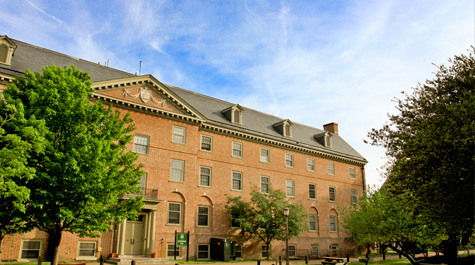Flashback to freshman Orientation: you are hot, sweaty, dehydrated and altogether exhausted by a long day of mandatory activities. You trek back to your dorm room, expecting an oasis, but no such relief awaits. Your room is stiflingly hot. You’d like a glass of water, but you have to walk down the hall each time you need to get a refill.
No air conditioning. No in-room sink. Located on the outskirts of campus, whether by the swampy banks of Lake Matoaka or the cobbled streets of Colonial Williamsburg. These phrases might describe most freshman halls on campus, but they do not apply to Jefferson Hall.
Many students were dismayed when Residence Life announced that Lemon Hall would become a freshman dorm and Jefferson Hall would become an upperclassman dorm. This may have been in part due to the reputation of freshman dorms on campus. Currently only three freshman dorms are fully air-conditioned and their locations are typically less than desirable. The prospect of living in a former freshman dorm as an upperclassman can make people squirrelly. But as a current (and possibly future) resident of Jefferson Hall, I think Jefferson deserves more respect.
Jefferson isn’t the first freshman hall to be converted to upperclassman housing. Current upperclassman dorms Barrett Hall and Dupont Hall were freshman halls before being changed to upperclassman housing, and Green and Gold Village previously functioned as fraternity housing. And as recently as the 2010-11 academic year, three of Jefferson’s four floors were occupied by upperclassmen (the basement was occupied by freshmen).
Jefferson is one of the three freshman dorms that are fully air-conditioned (the others are Reves and Yates), and it has a great location. It’s closer to Marketplace than any current upperclassman dorm, and it is mere steps away from Ewell and Washington Halls. For students who have most of their classes on the Sunken Garden, the location is arguably better than living in Dupont, the Randolph Complex or (god forbid) Richmond Hall.
The aesthetic of the building and its surroundings are other positive factors. Jefferson’s brick exterior contributes to the architectural atmosphere of Old Campus. And while the green space between Jefferson and Washington Hall is currently surrounded by chain-link fencing, it was open during most of the fall semester, giving residents space to grill, toss a frisbee around or just enjoy the weather.
The amenities don’t stop once you enter Jefferson. As soon as you walk in the building, you can feel the cool rush of central AC. According to the Residence Life website, the average size of a double in Jefferson is 160 square feet, which is larger than the average double square footage in any other freshman dorm.
However, Jefferson isn’t necessarily the best option when it comes to housing for upperclassmen. Several other upperclassman dorms boast similar locations (Barrett, Chandler and Landrum are close to the Sunken Garden on the south like Jefferson, while the Bryan Complex and Old Dominion Hall are situated to the north) and similar, if not better interiors featuring larger rooms and suite or private baths.
Still, there are also upperclassman dorms with worse locations. Dupont Hall is on the far west end of campus, which makes for a long trek to ISC or the Sunken Garden. Richmond Hall is closer to the School of Education than the Sadler Center or Swem according to Google Maps.
While it might not be able to fill the absence of One Tribe Place or Lemon Hall, Jefferson is a respectable dorm with plenty to offer. The rooms might not be palaces, but you’ll have a decent amount of room, a sink and air conditioning. The location is great for students with classes on both Old and New Campus. Living in Jefferson Hall has been a great experience for me, and I think it could the same for you.
Email Suzanne Cole at

